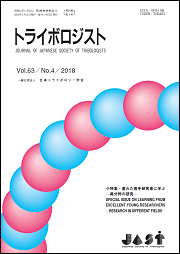Current issue
Special Issue on Machine Element Part for Automotive Engines Contributing towards Carbon Neutrality
Displaying 1-19 of 19 articles from this issue
- |<
- <
- 1
- >
- >|
Announcement
-
2024 Volume 69 Issue 4 Pages K4
Published: April 15, 2024
Released on J-STAGE: April 15, 2024
Download PDF (1965K)
Contents
-
2024 Volume 69 Issue 4 Pages M4
Published: April 15, 2024
Released on J-STAGE: April 15, 2024
Download PDF (240K)
Winners of 2023
-
2024 Volume 69 Issue 4 Pages 235-236
Published: April 15, 2024
Released on J-STAGE: April 15, 2024
Download PDF (1470K) -
2024 Volume 69 Issue 4 Pages 237-241
Published: April 15, 2024
Released on J-STAGE: April 15, 2024
Download PDF (3911K) -
2024 Volume 69 Issue 4 Pages 242-245
Published: April 15, 2024
Released on J-STAGE: April 15, 2024
Download PDF (4295K) -
2024 Volume 69 Issue 4 Pages 246-250
Published: April 15, 2024
Released on J-STAGE: April 15, 2024
Download PDF (1554K) -
2024 Volume 69 Issue 4 Pages 251-254
Published: April 15, 2024
Released on J-STAGE: April 15, 2024
Download PDF (1418K) -
2024 Volume 69 Issue 4 Pages 255
Published: April 15, 2024
Released on J-STAGE: April 15, 2024
Download PDF (708K)
Special Issue on Machine Element Part for Automotive Engines Contributing towards Carbon Neutrality
-
2024 Volume 69 Issue 4 Pages 256
Published: April 15, 2024
Released on J-STAGE: April 15, 2024
Download PDF (186K)
Explanation
-
2024 Volume 69 Issue 4 Pages 257-262
Published: April 15, 2024
Released on J-STAGE: April 15, 2024
Download PDF (2006K) -
2024 Volume 69 Issue 4 Pages 263-269
Published: April 15, 2024
Released on J-STAGE: April 15, 2024
Download PDF (1637K) -
2024 Volume 69 Issue 4 Pages 270-275
Published: April 15, 2024
Released on J-STAGE: April 15, 2024
Download PDF (2224K) -
Recent Trends of Cylinder Block in Internal Combustion Engine Contributing towards Carbon Neutrality2024 Volume 69 Issue 4 Pages 276-283
Published: April 15, 2024
Released on J-STAGE: April 15, 2024
Download PDF (3960K) -
2024 Volume 69 Issue 4 Pages 284-289
Published: April 15, 2024
Released on J-STAGE: April 15, 2024
Download PDF (1233K) -
2024 Volume 69 Issue 4 Pages 290-298
Published: April 15, 2024
Released on J-STAGE: April 15, 2024
Download PDF (2680K)
Up-to-date News Tribo-Episode -Tribologist Received Ph.D.-
-
2024 Volume 69 Issue 4 Pages 299-300
Published: April 15, 2024
Released on J-STAGE: April 15, 2024
Download PDF (3548K)
Original Contribution on Science
-
2024 Volume 69 Issue 4 Pages 301-311
Published: April 15, 2024
Released on J-STAGE: April 15, 2024
Advance online publication: December 13, 2023Download PDF (3411K)
Short Paper
-
The Effect of Crystallographic Orientation on the Friction Force and the Adhesion Force in Pure Iron2024 Volume 69 Issue 4 Pages 312-318
Published: April 15, 2024
Released on J-STAGE: April 15, 2024
Advance online publication: December 13, 2023Download PDF (1623K)
Report of the Society
-
2024 Volume 69 Issue 4 Pages 319-328
Published: April 15, 2024
Released on J-STAGE: April 15, 2024
Download PDF (3535K)
- |<
- <
- 1
- >
- >|
